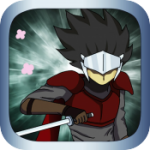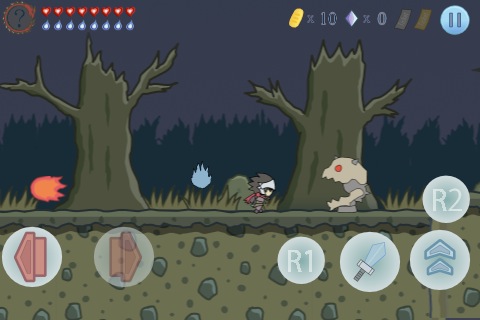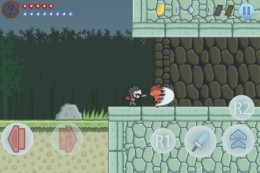 I’m going to go ahead and get this out of the way right now. Ninja Gaiga (Free) doesn’t look very nice. In fact, it looks simple, cheap, even amateur. Characters and many objects lack any sort of shading at all and the UI elements look butt ugly. You’d be forgiven for blowing past this game without a second glance as you rifle through the treasure trove that is the App Store.
I’m going to go ahead and get this out of the way right now. Ninja Gaiga (Free) doesn’t look very nice. In fact, it looks simple, cheap, even amateur. Characters and many objects lack any sort of shading at all and the UI elements look butt ugly. You’d be forgiven for blowing past this game without a second glance as you rifle through the treasure trove that is the App Store.
You may want to give this one another chance, though, because while this isn’t an amazing game, there’s a whole lot more going on here than the simple graphics would lead you to believe.
Ninja Gaiga starts off with very little pomp and circumstance. There’s a little preamble talking about Dark Lords and Soul Stones to set the action, and then it more or less just throws you to a world map with only one destination. Upon entering, you’ll find a save point, an old guy who tells you where to go next, and a shop. Ah, nostalgia.
The shop stocks several items, none of which you can afford, so all that’s left to do is go right, which brings you into the first level proper. Your actions are fairly limited. You can move left and right, jump, and swing your sword, all using virtual controls. There are also two more buttons labeled ‘R1’ and ‘R2’, but they don’t do anything at this point. The level plays out pretty typically, with a few easy ninja enemies that can be dispatched with only a few swings of your sword. They’ll leave behind coins, which you can use to buy most of the items at the shop.
So it goes, until you reach the next area, a castle town. In one of the houses, there’s a tunnel with a gap you can’t possibly cross. Could this mean? Yes, this is a Metroid-style action-adventure game, albeit broken up into distinct stages and considerably less complex. For those who aren’t familiar with Metroid, basically there are branching paths in stages that you need an item you don’t yet possess to access. You have to explore the stages in the correct order and find the items you need to progress in other stages, which will open up even more items and abilities. For an iOS reference, think Swordigo. Not all the items you find are essential, or are they all used for traversal. You can collect items that will permanently increase your health and magic meters, and bosses will often drop ninja magic that you can use in combat by equipping it at the shop.
The virtual controls are pretty good. I had no real issues jumping and slashing around the trap-filled, sometimes huge stages. The levels cover a variety of themes, from forests to volcanos to futuristic cities, and for the most part they all have their own unique enemies. The enemy behavior isn’t quite as varied as the sprites, but there are enough different types to create all kinds of nasty combinations throughout the game. There are also several bosses, though most of them are not really very difficult. Once you figure out their simple patterns, it’s just a matter of slashing them until they explode in a red burst.
The most difficult part of the later stages is simply making it to the boss with enough life, or at all for that matter. While you will find a few health pick-ups in each stage, the stages are quite long, so you’ll often find yourself running short. Should you run out of health, you’ll get booted back to the save point at the beginning of the game, forcing you to challenge the stage from the start.
Ninja Gaiga is forgiving in many ways. Your life bar is long and only gets longer as you go, being hit doesn’t toss you backwards like in many of the games this one is paying homage to, and falling into pits will just take one hit point from you and place you back where you jumped from. This keeps the game from being too frustrating, apart from the odd hit from iffy collision.
The quest is longer than it appears, ending up about average for this genre, which is to say a few hours long provided you don’t get stumped searching for an item or beaten down by one of the difficult later stages. One complaint I have is that every enemy drops money only, and you’ll very quickly buy out the shop’s stock, making the gold pointless for a large portion of the game. The occasional random health drop, even a small one, would have been nice.
As I said at the beginning, this game isn’t very good looking. There’s a great variety of sprites, which is probably part of the reason why they’re so simple in design, but it really hurts the game’s efforts of aping the style of the classics. A little bit of detail would have gone a long way. One thing I won’t complain about is the soundtrack, however. There’s a huge variety of music in this game, far more than I expected, and while it’s nothing I would listen to while working out or anything, each track does a nice job of complementing its stage’s theme.
If you’re a fan of the action-adventure genre, or if you want a fun game with a bit of old-school charm, you’ll probably dig Ninja Gaiga. It could do with a lot more visual refinement and a little more flesh on the gameplay bone, but I found myself pleasantly surprised by the overall amount of content here. I can’t see myself revisiting the game often, but I had a lot of fun making my way through the game.


